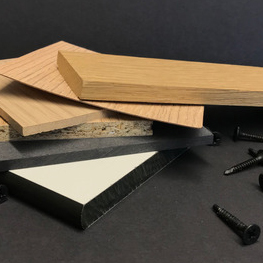The surface layers are often a part of the hotel interior that you don't think about, it's just there. But when you look more closely, you realize that the surface layer on the walls and interior make up a large part of the whole. Which surface layers fit where and what advantages and disadvantages do the different materials have? We clarify the concepts for the next renovation.
1. (High pressure) laminate
Laminate is a material that usually consists of a number of tightly compressed sheets of paper. The number of sheets controls the thickness of the laminate and its properties. A high-pressure laminate can be produced in thicknesses up to 20 mm and the surface can be textured to imitate wood or other materials. In addition, the laminate is available in many different colors and textures. It requires no care in the form of oiling, grinding or the like. A laminate also does not absorb liquid, so rings from coffee cups or the like can be easily wiped off. Some laminates have a matte surface (so-called anti-fingerprint) which reduces the risk of fingerprints and grease stains being visible. Wet spots may be visible but disappear as they dry.
Laminate has a hard and durable surface that can withstand high wear and tear and is therefore recommended for exposed surfaces in public environments. Its long lifespan is good for both the environment and your wallet.
2. Compact laminate
A high-pressure laminate with a thickness of over 2 mm is called Compact Laminate. An extremely durable material that can be used both indoors and outdoors because it does not absorb water and is "dead". Compact laminate lacks a traditional carrier board and consists only of tightly compressed sheets of paper. Compact laminate is advantageously used in those parts of your hotel interior that must withstand high loads and abrasion.
3. Melamine
Melamine, also called Chip Melamine and Direct Laminate, is a variant of laminate that is thinner and with lower production costs. Unlike laminate, which is made from several layers of kraft paper, Melamine consists solely of a decorative paper. The decorative paper is impregnated for extra protection against wear. Despite the thin layer, the melamine is a durable material and is suitable for public environments. The thin Melamine also has a less hard surface than other laminates, which i.a. is positive from a sound point of view, less rattling sound in e.g. restaurants and lobbies. As the melamine is so thin, it can have a structure imprinted according to the underlying wood pattern. Something that cannot be done with the harder laminates.
4. Wood veneer
Wood veneer is a thin layer of real wood glued to a wood fiber board as a carrier. Wood veneer is made from the finest wood in the log, which gives a luxurious feel. Veneer is less durable than laminate/melamine and is therefore most common in home environments. In a public environment, there is usually too much wear and tear for veneer to be an economically justifiable alternative. Wood veneers are usually oiled or varnished and cannot be sanded. As wood veneer is a "living material", the color of UV-exposed areas of the veneer will change over time. It can be an effect you are aiming for, but usually it is not desirable in a public environment.
5. Solid wood
Solid wood, i.e. real wood through and through, is not as durable as laminate and melamine although there are harder and softer woods. Solid wood can be resanded and needs care to maintain its surface. Solid wood gives a similar feel to veneer but is significantly more durable, although it may require re-sanding and the like. If you are not afraid of patina or are looking for a rustic feel, solid wood can be an alternative. Furniture made of solid wood has a long life if it is cared for correctly. There are many different finishes (eg, oil, stain, varnish) that have their different strengths and weaknesses. If you are interested in working with wood in your interiors, we can help you find the right type of wood and give you handling advice.

You can read more about different types of laminate at Wikipedia

